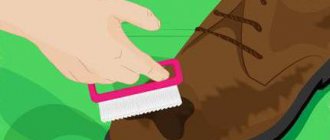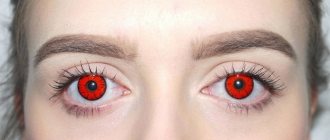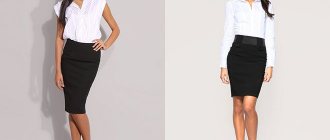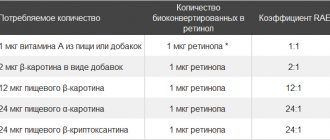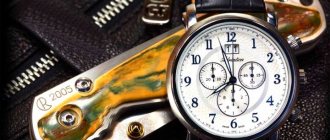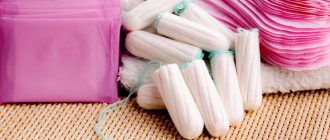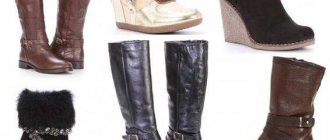High rise
A key guideline when choosing a good shoe can be a high instep. This technique always works effectively in practice, because this feature beautifully arches the foot and makes it visually more compact.
Modern fashionistas are incredibly lucky, because current shoes with a high instep can please them with extraordinary comfort. For example, pairs with stable heels or wedges often boast this property.
But among our readers there will probably be girls who are categorically opposed to heels. Stylists have a great offer for them too. In order for a pair of shoes to visually lengthen your legs and not focus attention on the size of the foot, it should be matched to the color of the bottom of the outfit (for example, you can focus on the tone of tights, trousers, skirt or dress). The properties of this color vertical always show themselves perfectly in practice.
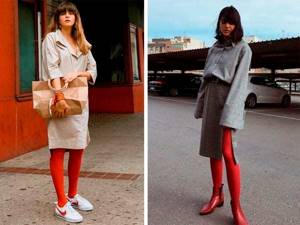
Interesting: Street fashion – summer 2020
Who buys shoes a size larger?
Most of us will answer this question - frugal mothers. Indeed, they buy sandals and sneakers for children to grow into. To prevent shoes from slipping, they put a piece of cotton wool in the sock; this method has been known for a long time. Or they buy winter boots with a size reserve so that in severe frost they can be warmed up with a thick sock.
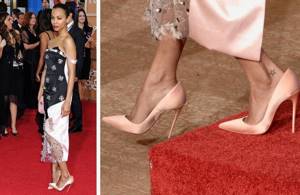
Recently, not only children have begun to use this same technique. It is mainly used by women who have to wear high-heeled shoes for a long time. Therefore, ladies want to make wearing shoes more comfortable. After all, it is the fair sex who wear heels for the sake of elegance of the silhouette, grace and luxurious gait.
But in some Asian countries, women buy shoes 1, or even 2, sizes larger, and they do this not only with stiletto heels.
Why do stars wear shoes like these?
There is no special secret in choosing large size shoes - everything is banally simple. Public people: movie and pop stars, TV presenters and other representatives of the social elite - are obliged to pose for hours, act and spend 24 hours in heels. Louboutins and high heels are beautiful, but terribly uncomfortable! Even young people’s legs begin to swell by the end of the event, what can we say about an older woman. To make it easier to endure long periods of standing in an upright position, celebrities began to resort to a simple method - buying shoes larger than needed. This way they create the most comfortable conditions for their swollen legs. The foot, which has become enlarged due to swelling, is not rubbed by the material of the shoes, and inconvenience with the shoes is minimized.
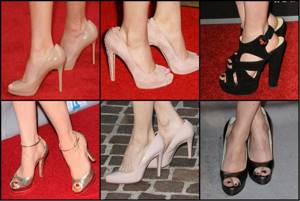
Advice! If you are constantly on your feet for work or stiletto heels are part of your dress code, you can also use the popular star method and wear shoes a size larger.
Why do women buy large shoes in Japan?
Japanese women are big originals, but they have so many reasons to wear shoes 2 sizes larger. We have compiled a selection of explanations that will help you understand this tradition.
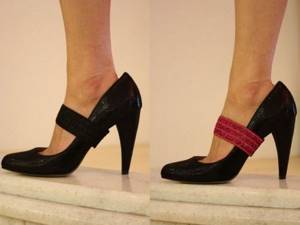
- In Japan, unlike European countries, it is customary to take off your shoes at home. That’s why you buy loose shoes of any style: it’s easier to take them off and put them on .
- Historically, Chinese and Japanese women wore uncomfortable wooden shoes. They mocked the girls' feet by swaddling them to make their feet small. A small foot in ancient Asia was the standard of femininity. This is probably why modern women, as if in protest, wear big, bulky shoes.
- In boots that are a size or two too large, the foot looks, according to Japanese girls, cute and childishly charming . Lovely Japanese women play in contrast.
- Emphasizing sexuality . A foot that easily slides into a shoe looks more attractive than a foot that is hardly squeezed in with the help of a shoe blade.
- In a humid, warm climate, it is not so hot in spacious slippers and shoes
. - The desire to avoid deformation of the foot by an uncomfortable tight pair.
And visitors to the country also assume that Asian fashionistas first of all pay attention to the beauty of the model. If you like the shoes, then the size doesn't matter .
Nude pumps
Girls with large feet often convince themselves that elegant nude pumps are not the best choice for them. But stylists are quick to assure them of the opposite – such a versatile pair of shoes is a very winning solution. This fact is very simple to explain: the fact is that beautiful and comfortable shoes in beige or light pink colors practically blend with the skin tone and, due to this property, do not create an emphasis on the size of the foot. On the contrary, they even slightly hide this meaning.
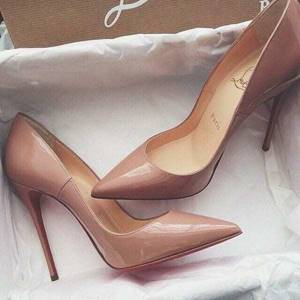
Nude shoes can be safely included in the “must-have” category also because they are not subject to fleeting fashion trends and can please you with their excellent versatility. You can see from your own experience that your favorite pumps can look great paired with a romantic dress or in tandem with comfortable jeans.
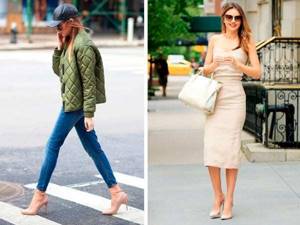
How to choose winter shoes - simple rules for choosing the right quality shoes
Thin - it will freeze and will not protect your feet in the cold. The next indicator is relief. The more patterns are embossed on the sole, the easier it will be to maintain balance in icy conditions. An example is professional sports winter shoes; they have a textured sole with an individual pattern specific to a particular brand. Of course, it’s easier for men both in summer and winter. They don't need to walk on wedges, heels, or platforms. Women do not refuse high heels and platforms even in the winter season. If you are a fan of high heels, then for winter shoes it should be stable and reliable, and not be plastic. To check, place the boots on a flat platform and press on the instep. If the heel starts to “move” back, you shouldn’t take such a pair, then you won’t have problems with sliding and “free flights”. The platform and wedge must be well glued. However, keep in mind that in icy conditions it is more prudent to leave high-heeled shoes at home so as not to become a traumatologist's patient.
HOW TO CHOOSE THE CORRECT WINTER SHOES BY SIZE
You should not buy shoes without trying them on, especially the winter version! There are no two identical pairs. Shoes from different manufacturers vary significantly in size. That is, buying online for yourself is out of the question, since the boots are size 38 on a Chinese website, in fact they may turn out to be 36. Put on both boots, walk around the store, sit in them. You should immediately feel comfortable. Do not “fall for” the seller’s persuasion, such as: “the fur will shrink and the skin will stretch.” This is pure scam. The shoes should not be tight, the big toe should not feel the toe, and the boot should not squeeze the leg. Shoes one size too big are also bad. Deformation of the foot is possible, and loose shoes can cause a fall. Before trying on, put on a thick sock, because in winter you usually need to keep warm.
ACCESSORIES
Unbutton and fasten the zipper several times - the process should go easily and not “stick”. Inspect the accessories: buttons, fasteners, chains, buttons. They must be securely fastened. And the fewer of them, the better, since decorative elements often wear out, darken, or get lost, which gives an unkempt appearance to almost new shoes. Yes, and most importantly, compare the right and left boots; it is not uncommon that they do not match in color, leather texture, or even size.
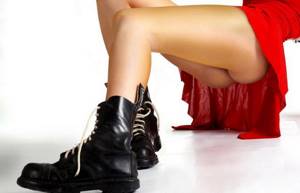
Dana BOBAN
Knee-high boots
Having large feet will no longer be a problem as soon as you learn how to choose shoes correctly. So, during the cold season, high boots with a round toe can be the optimal solution. The elegant length will serve as an effective distraction, and the flirtatious rounded nose will make the feet visually more fragile. If you can boast of slender legs, then prefer a pair with laces - such a decorative technique will also add elegance and femininity to your look.
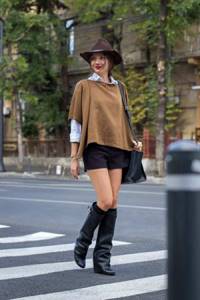
Wide boots
It would seem that with massive feet, only tight pairs of shoes are appropriate. But it was not there! Modern stylists have made a real discovery in the fashion world and have proven that trendy boots with a wide top are also considered a good idea for such natural characteristics. The whole secret lies in this: against the background of such shoes, the foot is practically lost and due to this it looks more proportional. If you want this effect to manifest itself 100% in practice, you can give preference to modern shoes with soft folds and a straight shaft.
https://youtu.be/https://youtu.be/8JdUm-6Ycyw
_
How to choose the right winter shoes?
Amazing numbers - 98% of all children are born with healthy legs. At the same time, two thirds of adults suffer from various deformities of the toes or the entire foot. The main reason is too small or too large a shoe size worn in childhood. Orthopedists warn: diseases of the spine, joints, neuralgia, and cardiovascular dystonia arise from wearing the wrong shoes. With the current selection, it is quite easy to choose good shoes for any budget. Many people ask why buy boots for a child for 2-3 thousand for one season. The fact is that cheap shoes are rarely made according to all the rules for making good shoes for children. It is very important how the load on the muscles is distributed when walking. The development of the organism as a whole depends on this. Legs are an important part of the body and should not be skimped on. Fortunately, domestic manufacturers also have something to brag about - a little more, a little more, and our shoes will be in no way inferior to overseas “things”.
THREE IMPORTANT FACTORS: length and fullness of the foot, arch
Length. Place your child's foot on a piece of paper and carefully trace it. Measure the length of your foot with a centimeter: from the bottom to the protruding part of the sock. Take this drawing with you to the store and give it to the consultant, even if the child is with you.
Completeness. Many companies produce shoes in three sizes: wide, medium and narrow. If your child has narrow feet, do not buy shoes with wide toes; remember that the load on the muscles is not distributed correctly. This is very important: the foot should not dangle inside the boot.
Climbing or lifting. The instep is the upper part of the foot that transitions to the lower leg. When the transition (at the front) is smooth, the slope is a high rise. It is not so easy to try on shoes with a high instep if the boots have too narrow a transition between the foot and the lower leg. Interesting fact: there are now a lot of Italian and Turkish shoes on sale, designed for narrow feet.
!!! The structural features of a Russian person's feet are completely different - wide and short feet, high instep, so shoes made in Germany and Finland, which have won the hearts of citizens in recent years, are more suitable for us. According to mothers who buy children's shoes, high-rise shoes are produced by the following companies: Kotofey, Kuoma, Superfit , and Norwegian Vikings . Narrow shoes: Ecco, Ricosta, Antelope , Vietnamese Vikings .
Criterias of choice
CHILDREN UNDER ONE YEAR OF ONE YEAR
Strong advice from experts: if a child is just starting to walk in winter, do not buy shoes “for walking” before the start of the season. Don't give in to the general seasonal panic: the choice of shoes in December and January will be better than in the fall, and you will also save on sales. It is impossible for a child of 6-7 months to try on winter boots properly, the leg muscles are not yet strong enough, the leg will “crumple”, and not a single boot will fit, except the wrong one (oversized). Buy fur booties for the first time - and felt boots (two sizes larger than at the time of purchase) for November-December. When the child walks confidently, then the time will come for “adult” boots. You still can’t guess the size; a child’s foot can grow three sizes from seven months to one year. For walking in a stroller, the ideal shoes would be felt boots - ordinary felt boots from the market. Has the child gone? The best shoes are leather boots with natural fur. If your budget allows, buy textile shoes with a membrane with a fur lining, but this is a completely unnecessary purchase for up to a year and a half. The child does not yet run around on walks continuously for 2 hours; he does not need the membrane. The first boots must have a small heel. This helps the foot develop properly and also shapes the gait. Fastener: zipper or Velcro.
CHILDREN AFTER A YEAR
TRYING ON: It’s best to try on shoes in the evening. Even a child's legs swell a little in the evening. Shoes can only be tried on while standing! In this position the foot is larger.
SIZE. The optimal one is when there is 1-1.5 cm (an adult’s finger) between the toe of the shoe and the child’s fingers. Empty space creates a warming effect, but if it is too large, the effect will be the opposite. When walking, the foot should move, it slides inside the boot - this is normal, that’s what the reserve is for. Shoes that fit tightly limit slipping, the toes are compressed, and blood circulation is impaired. The foot in the boot should be well fixed and not dangle. How many pairs of shoes does a child need? It is advisable to have more than one pair, and not at all because of lordly manners. Shoes have the right to rest; they must dry and straighten out. You can buy two pairs of shoes for “colder” and “warmer” occasions - for example, for trips in the car/shopping and walking. Many mothers buy felt boots for their own peace of mind.
The winter season begins on November 1 and ends on April 1. Therefore, if you purchased shoes, say, on January 1, the shoe warranty extends until the end of this winter season and covers the period of the future winter season until January 1.
UPPER MATERIAL
Leather, textiles
These materials are breathable and meet hygienic requirements. In addition, leather and textiles easily “sit” to the shape of a child’s foot. Remember that textiles will not stretch when worn, so you should not buy them in advance. Leather shoes will stretch a little in length. Cheap leatherette shoes are almost never used in the production of well-known domestic or foreign children's shoes and crack in the cold. How to spot faux leather: It's cooler to the touch and doesn't get hot when you place your palm on it. Also try looking for a loose piece of leather near the lock. If you can remove a thread from such a cut, then you have shoes made of artificial materials in your hands. The lock on the shoe should be covered from the inside with fur, not leather, otherwise the foot will freeze.
Care: dry at room temperature, not on a radiator. To make wet shoes dry faster, you need to wipe them outside and inside and stuff them with newsprint. Lubricate dry shoes with cream, especially carefully along the junction of the leather with the sole (where cracks most often occur). Keep in mind that without special treatment, any leather shoes will get wet in rainy weather!
Nubuck
The so-called disheveled leather has a slight hairiness effect. Nubuck is similar to velvet. The shoes are beautiful, but in our reality they are completely impractical. In nubuck boots you can beautifully ride in the car or walk around the shopping center. There is nothing to do on the Yekaterinburg street, decorated with slushy mud from the roads, salts and reagents. Unless you walk in exceptionally fresh and clean snow. Only extreme parents buy nubuck boots for children: these shoes require careful care and cannot withstand moisture.
Care: nubuck and suede are afraid of water, so they are usually cleaned with a special brush. Heavy stains can be removed with soapy water and ammonia. After cleaning, it is necessary to apply a water-repellent agent.
OUTSOLE, INSOLE
The sole of the boot or shoe should bend easily, this provides the effect of walking barefoot, and shoes with soft soles slip less. Bend the upper part away from the sole and check that the seam remains straight and that the glue is not coming off. Sometimes the sole is securely welded to the shoe. It is desirable that it be made of polyvinyl chloride (PVC) or thermoplastic elastomer (TEP). These materials are non-slip. Also, the soles are made of polyurethane, it is light and flexible, but colder and more slippery. The insole is only fur. Any mother will be happy if in the store she managed to pull the insole out of a boot in order to measure the shoes in the absence of the child - or apply the insole to the foot of a fidget. You can be happy, but you can’t buy such shoes. The insole in winter shoes must be securely sewn (glued). In the manufacture of insoles, manufacturers use a variety of systems that reduce the load on the foot - for example, air-cushioned insoles.
On the sole or inside the boot in shoes of decent brands there are markings: three patterns of the shoe (upper, sole and lining) and three symbols next to them. The skin symbol means leather, the diamond symbol means synthetics, and the mesh symbol means other materials.
INSULATION
Fur
The fur should be natural so that the foot can breathe and not freeze: tsigeyka, mouton. All these are special methods of processing sheepskin fur. Synthetic fur is quite rare these days; it is distinguished by a characteristic shine; artificial fur is also shiny, natural fur is dull. How to determine: Unfasten the clasp and push the fur apart with your fingers - it should be on the skin, not on the fabric.
Care: Never place shoes on a radiator or heater, otherwise the leather will lose all its properties. Shoes with fur dry properly only at room temperature.
Membrane
A thin fluoroplastic film that allows moisture to pass through in only one direction—outward. It has a huge number of holes per unit area. These holes are very small in size, so water molecules in the form of steam pass through them, but drops (due to the fact that they are many times larger than molecules) do not pass through. Types of membrane materials: gore-tex, sympathex, ricotex, etc., they all have a different structure (for example, sympathex is a membrane without pores, moisture is carried through special chemical bonds) and work on the same principle. The membrane will work in any case, but it is better to help it - put tights or socks containing a certain percentage of synthetics (“stretchy”), or special thermal socks on the child’s legs. Shoes with a membrane are designed for temperatures down to -10; at lower temperatures they freeze. For cold winters there is a membrane + sheep wool option; it can withstand temperatures down to -30.
Care: do not dry on a radiator or heater, the membrane is destroyed. It is recommended to treat shoes with special water-repellent agents.
Gore-Tex membrane: Superfit (Austria), ECCO (Denmark), RICOSTA (Germany), Elefanten (Germany), Viking (Norway).
Sympatex membrane: Scandia (Italy). Antelope uses its own membrane, a-tech, and uses SPIRA-TEX (Italy) and KING-TEX (Taiwan) membranes.
Thinsulate
At the moment - one of the best synthetic insulation: lightweight, waterproof, durable. In terms of heat-protective properties, boots with Thinsulate can be placed on a par with boots lined with natural fur. Temperature: up to -30. Thinsulate boots are recommended both for active walks and for passive time spent outside, that is, a child lying in a stroller will not freeze either.
Thinsulate shoes are produced by Merrell , Mursu (Finnish), Kamik, I-GLA (Norwegian).
White color
Choosing the right shoes to make your feet appear smaller will also help if you choose a light palette. An absolute hit in recent seasons have been pairs in refreshing white colors, which look especially impressive in winter and autumn looks. Stylists confirm that light-colored shoes look light, fashionable and airy, and also beneficially conceal the actual size of the feet. To enhance this magical property, you can choose a pair that additionally has a high rise in the form of a wedge or wide heel, or with a rounded toe.

Loafers
With large feet, stylists also recommend not to ignore the relevance of loafers - an incredibly feminine and universal trend. Moreover, the ideal solution would be a pair that has a noticeable high heel. Cross seams or contrasting inserts in the design of loafers would also be useful.
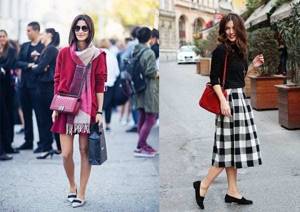
Flip-flops
The optimal summer shoes, in which the foot visually looks smaller, are undoubtedly flip-flops and sandals with straps on the toes. It would be great if such a pair were made in elegant nude colors.
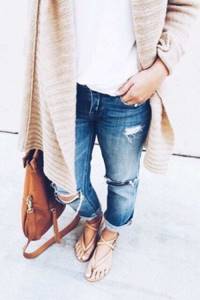
True, when choosing this summer shoe, you should make sure that its design does not include an abundance of thin, elegant straps. It is better if these decorative details are quite noticeable. Moreover, the fewer of them there are, the better the shoes promise to look.
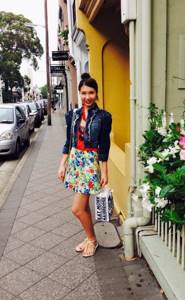
Interesting: Beautiful hairstyles for summer 2020
Contrast Cape
If your feet are quite long, stylists recommend paying special attention to those pairs of shoes in which the leg is clearly divided horizontally. As a rule, this technique is embodied in various decorative techniques, for example, in a contrasting cape. If you choose such stylish shoes, then you won’t even be afraid of a flat ride or a sharp toe in its design.
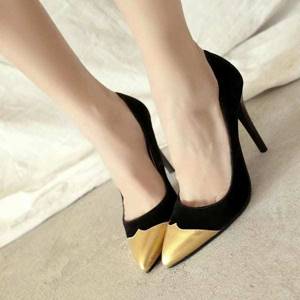
How to choose your shoe size?
Many people think that the most important thing is to choose the right size.
The most common are French (35-47) and English (2-12) sizes.
When choosing a size, most people know that shoes should not be small. Wearing shoes that are too small for a long period of time can lead to severe foot deformities, painful hallux valgus and hammertoes. Tightly clenched toes can cut off circulation in the feet.
However, not everyone knows what happens if the shoes are too big. In this case, the rolling movement of the foot is disrupted; there is still a little space left in front of the toes in the toe of the shoe, which the fingers cannot control, and when walking, the foot hits the floor more harshly than it should happen with a smooth rolling movement. The load on the joints increases and over time the metatarsus will “reduce”.
So, first choose the right size. Many people have different lengths of feet, so when buying, focus on the foot that is longer. If the model you like does not have half sizes and you have to take shoes a little longer than necessary, you can use an insole or half-insole to adjust the size.
According to modern statistics, men often buy shoes one size, or even two, too large. The fact is that larger shoes are automatically wider, so with wide feet it seems that the shoes are larger and fit better.
If the shoes fit your size, but still feel too tight, under no circumstances take a size larger. Better look for another model.
In fact, our foot is three-dimensional; the indicated size only indicates the length of the shoe.
Red Herring
Another great technique with excellent effectiveness is the use of accents in the image itself, which allow others not to pay attention to your foot size. That is, if you combine neutral shoes with a bright belt, scarf or brooch, this feature will definitely not be noticeable. This recommendation is a great reason to experiment with the selection of accessories!
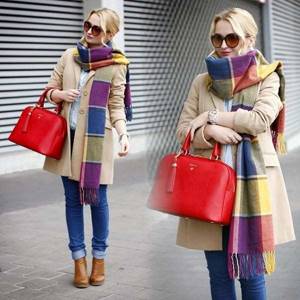
TYPES OF WINTER SHOES
Snowboots
Three-layer felt boots: the top layer is polypropylene (durable, breathable material), the middle layer is a membrane, the third layer is natural wool felt. The inner woolen “felt boot” is removed. Snow boots are considered off-season footwear with a temperature range of +5/-35; they are worn even in summer instead of rubber boots. Information about snowboots is contradictory: some write that they are suitable down to a temperature of -10, other manufacturers set the bar at -30. Everything, as usual, depends on the frost resistance of the individual child.
Domestic snow boots - Zebra, Kotofey , Polish Demar , Finnish Canadians .
Leather boots with natural fur
This is a classic of the genre. Genuine leather allows your feet to “breathe” and creates a healthy microclimate inside the shoes. Weigh the boot in your hand and check if it is light enough. Place it on the floor and see if the sock rides up. Don’t be lazy - open and close the zipper ten times, play with the Velcro, because the fastener on the boots is the weakest point, and you have to live with it. Fur-lined shoes are suitable for children with low walking speed; active children will feel a little hot in them. “Disadvantages” of leather shoes with fur: they are not designed for severe frosts, they are hot indoors, and with sudden temperature changes (from the store to the street) the foot will freeze.
Membrane boots
The shoes are made using the latest technologies. Its advantages: extremely breathable and waterproof. Upper material: textile, inside - membrane, lining: fur or wool with synthetics. Boots with a membrane are lightweight and do not require a wool sock. All seams are taped, street moisture will not get inside. These shoes are worn from November to April; they are considered out-of-season, that is, in the “autumn-winter” category. As a rule, membrane boots are not cheap. The market is steadily growing, and today you can buy inexpensive membrane shoes with good characteristics.
For example, licensed “Vietnamese” Viking , domestic Zebra Deitex boots , Romanian Bagheera on a GT-TEX membrane.
Pedicure
If you want to visually turn into Cinderella, you can use another interesting trick in your summer look, namely, creating a pedicure in dark shades. This simple trick will put into practice a visual illusion, that is, it will make the foot small. Moreover, a girl can use not only black varnish, but also its alternative in the form of a brown, blue, emerald or purple pedicure shade.
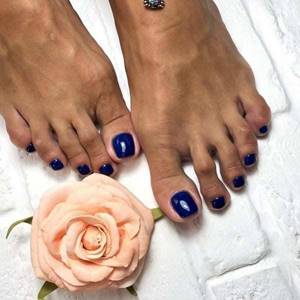
https://youtu.be/https://youtu.be/N1MpdSFttdE
_

